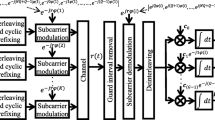Abstract
This paper deals with uplink Direct-Sequence Code Division Multiple Access (DS-CDMA) transmissions over mobile radio channels. A new interference cancellation scheme for multiuser detection, calledSIC/RAKE, is presented. It is based on a modified multistage Successive Interference Cancellation (sic) structure that enables efficient detection in multipath propagation environments, thanks to a single userRAKE receiver incorporated in each unit of thesic structure. Furthermore, a modified version of thesic structure, calledSIC/MMSE, that ensures convergence to theMMSE detector rather than to the decorrelating detector has been suggested. The convergence of theSIC/RAKE andSIC/MMSE methods is proved. Simulation results for the Universal Mobile Telecommunication System (UMTS) have been carried out for flat fading Rayleigh multipath channels, showing that the proposed detector is resistant to the near-far effect and that low performance loss is obtained compared to the single-user bound.
Résumé
Dans cet article, on considère la liaison montante d’un système de radiocommunications avec les mobiles à Accès Multiple par Répartition en Code (AMRC). Une nouvelle structure de suppression de l’Interférence d’Accès Multiple (IAM), baptiséeSIC/RAKE, est présentée. Elle est basée sur l’emploi d’une structure de suppression itérative d’interférence (sic) qui permet une détection efficace en présence de canaux à trajets multiples grâce à la mise en œuvre d’un récepteurRAKE mono-utilisateur dans chacune des unités de base du récepteursic. De plus, une version modifiée de la structuresic, baptiséeSIC/MMSE, qui implémente ité-rativement le détecteur MMSE plutôt que le décorrélateur, est proposée. On démontre la convergence des structuresSIC/RAKE etSIC/MMSE. Des simulations sont présentées pour le systèmeUMTS et des canaux de propagation de Rayleigh à trajets multiples. Les résultats montrent que la structure proposée est résistante au phénomène d’éblouissement et que la dégradation des performances en termes de probabilité d’erreur est faible par rapport à la borne mono-utilisateur.
Similar content being viewed by others
References
Verdu (S.),Multiuser detection, Cambridge University Press, 1998.
Moshavi (S.), « Multi-user detection for ds-cdma communications »,IEEE Commun. Mag., pp. 124-136, October 1996.
Hallen (A.D.), Holtzman (J.), Zvonar (Z.), « Multiuser detection for CDMA systems »,IEEE Personal Communications, pp. 46-58, April 1995.
Koulakiotis (K.), Aghvami (A.H.), « Data detection techniques for ds/cdma mobile systems: A review »,IEEE Personal Communications, pp. 24-34, June 2000.
Verdu (S.), « Minimum probability of error for asynchronous gaussian multiple-access channels »,IEEE Trans. Information Theory,IT-32, pp. 85–96, Januray 1986.
Mohr (W.) Prasad (R.), Konhauser (W.),Third Generation Mobile Communication Systems, Artech House Publishers, 2000.
Webb (W.), « gsm, umts and the Third Generation », GSM Quarterly, pp. 12-16, July 1996.
Glisic (S.G.), Leppanen (P.A.),Code Division Multiple Access Communications, Kluwer Academic Publishers, 1997.
MiLSTEIN (L.B.), « Wideband code division multiple access »,IEEE Journal on Selected Areas In Communications,18, n° 8, pp. 1344–1354, August 2000.
Ammar (M.), Chonavel (Th.), Saoudi (S.), « A new multi-stage successive interference cancellation structure for multipath asynchronous ds-cdma signals », inThird IEEE Signal Processing Workshop on Signal Processing Advances in Wireless Communications, Taoyuan, Taiwan, March 2001.
Ammar (M.), Chonavel (Th.), Saoudi (S.), « Multi-stagesic for uplink umts multiuser receiver over multi- path Rayleigh channels », inIEEE VTC Spring, Rhodes, Greece, May 2001.
Divsalar (D.), Simon (M.K.), Raphaeli (D.), « Improved parallel interference cancellation for CDMA »,IEEE Transactions on Communications,46, n° 2, pp. 258–268, February 1998.
Dongning (G.), Rasmussen (L.K.), Lim (T.J.), « Linear parallel interference cancellation in long-code CDMA multiuser detection »,IEEE Journal on Selected Areas In Communications,17, n° 12, pp. 2074–2081, December 1999.
Xue (G.), Weng (J.), « Adaptive Multistage Parallel Interference Cancellation for CDMA »,IEEE Journal On Selected Areas In Communications,17, n° 10, pp. 1815–1827, October 1999.
Hui (L.C.A.), Ben Letaief (K.), « Successive interference cancellation for multiuser asynchronous ds-cdma detectors in multipath fading links »,IEEE Transactions on Communications,46, n° 3, pp. 384–391, March 1998.
YÔon (Y.C.), Kohno (R.), Imai (H.), « A spread spectrum multiaccess system with cochannel interference can- cellation for multipath fading channels »,IEEE Journal on Selected Areas In Communications,11, n° 7, pp. 1067–1075, September 1993.
Rasmussen (L.K.), Lim (T.-J.), Johanson (A.L.), « A matrix algebraic approach to successive interference cancellation in cdma »,IEEE Transactions on Communications,48, n° 1, pp. 145–151, January 2000.
Golub (G.H.), Loan (C.F.V.),Matrix Computations, North Oxford Academic, 1983.
Ciarlet (P.G.),Introduction à l’analyse numérique matricielle et à l’optimisation, Masson, 1988.
Divsalar (D.), Simon (M.K.), « Improved cdma performance using parallel interference cancellation », Tech. Rep., JPL Publication, 1995.
Dongning (G.),Linear Parallel Interference Cancellation in cdma, Ph.D. thesis, National University of Singapore, 1998.
Markku (J.J.),Multiuser demodulation for ds-cdma systems in fading channels, Ph.D. thesis, Oulu University, Department of Electrical Engineering, Oulu, Finland, 1998.
Ojanpera (T.), Prasad (R.), « An overview of air interface multiple access for IMT-2000/umts »,IEEE Commun. Mag.,36, pp. 88–95, September 1998.
Third Generation Partnership Project (3gpp) Technical Specification Group (tsg) Radio Access Network (ran) Working Group 1 (wg1), « Spreading and modulation (fdd) », Tech. Rep., 3gpp, ts 25.213 v2.3.0, 1999-9.
Third Generation Partnership Project (3gpp) Technical Specification Group (tsg) Radio Access Network Working Group 1 (wg1), « Physical channels and mapping of transport channels onto channels (fdd) », Tech. Rep., 3GPP, TS 25.211 v2.5.0, 1999-10.
Vipin (S.), « Simulation of Rayleigh fading Clarke’s model using spectrum shaping », Tech. Rep., Winlab, 1998.
Ammar (M.), Chonavel (Th.), Saoudi (S.), « Nouvelle structuresic itérative avec estimation conjointe du canal pour la liaison montante du système umts-fdd », ingretsi, Toulouse, France, September 2001.
Ostrowski (A.M.),Solution of Equations and Systems of Equations, Academic Press, New York, 2nd edition, 1966.
Author information
Authors and Affiliations
Corresponding author
Rights and permissions
About this article
Cite this article
Ammar, M., Chonavel, T. & Saoudi, S. Iterative successive interference cancellation for multi-user DS/CDMA detectors in multipath channels. Ann. Télécommun. 57, 105–124 (2002). https://doi.org/10.1007/BF02994613
Received:
Accepted:
Issue Date:
DOI: https://doi.org/10.1007/BF02994613
Key words
- Mobile radiocommunication
- Cellular network
- Code division multiple access
- Direct sequence spread spectrum
- Multipath propagation
- Rayleigh fading
- Multichannel detection
- Umts
- Iteration
- Signal interference
- Mean square error




